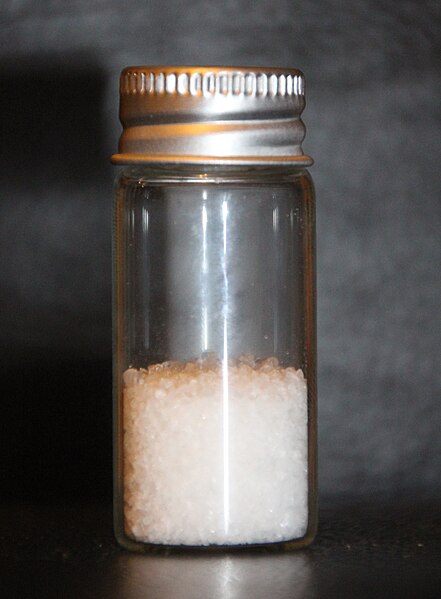Polyvinyl alcohol (PVOH, PVA, or PVAl) is a water-soluble synthetic polymer. It has the idealized formula [CH2CH(OH)]n. It is used in papermaking, textiles, and a variety of coatings. It is white (colourless) and odorless. It is sometimes supplied as beads or as solutions in water.
Uses

- Polyvinyl acetals: Polyvinyl acetals are prepared by reacting aldehydes with polyvinyl alcohol. Polyvinyl butyral (PVB) and polyvinyl formal (PVF) are examples of this family of polymers. They are prepared from polyvinyl alcohol by reaction with butyraldehyde and formaldehyde, respectively. Preparation of polyvinyl butyral is the largest use for polyvinyl alcohol in the U.S. and Western Europe.
Polyvinyl alcohol is used as an emulsion polymerization aid, as protective colloid, to make polyvinyl acetate dispersions. This is the largest market application in China. In Japan its major use is vinylon fiber production.
Some other uses of polyvinyl alcohol include:
- Paper adhesive with boric acid in spiral tube winding and solid board production
- Thickener, modifier, in polyvinyl acetate glues
- Textile sizing agent
- Paper coatings, release liner
- As a water-soluble film useful for packaging. An example is the envelope containing laundry detergent in "liqui-tabs".
- Feminine hygiene and adult incontinence products as a biodegradable plastic backing sheet.
- Carbon dioxide barrier in polyethylene terephthalate (PET) bottles
- As a film used in the water transfer printing process
- As a form release because materials such as epoxy do not stick to it
- Movie practical effect and children's play putty or slime when combined with borax
- Used in eye drops (such as artificial tears to treat dry eyes) and hard contact lens solution as a lubricant
- PVA fiber, as reinforcement in concrete
- Raw material to polyvinyl nitrate (PVN) an ester of nitric acid and polyvinyl alcohol.
- As a surfactant for the formation of polymer encapsulated nanobeads
- Used in protective chemical-resistant gloves
- Used as a fixative for specimen collection, especially stool samples
- When doped with iodine, PVA can be used to polarize light
- As an embolization agent in medical procedures
- Carotid phantoms for use as synthetic vessels in Doppler flow testing
- Used in 3D printing as support structure that can then be dissolved away.
Fishing
PVA is widely used in freshwater sport fishing. Small bags made from PVA are filled with dry or oil based bait and attached to the hook, or the baited hook is placed inside the bag and cast into the water. When the bag lands on the lake or river bottom it breaks down, leaving the hook bait surrounded by ground bait, pellets etc. This method helps attract fish to the hook bait.
Anglers also use string made of PVA for the purpose of making temporary attachments. For example, holding a length of line in a coil, that might otherwise tangle while the cast is made.
Preparation

Unlike most vinyl polymers, PVA is not prepared by polymerization of the corresponding monomer. The monomer, vinyl alcohol, is unstable with respect to acetaldehyde. PVA instead is prepared by first polymerizing vinyl acetate, and the resulting polyvinylacetate is converted to the PVA. Other precursor polymers are sometimes used, with formate, chloroacetate groups instead of acetate. The conversion of the polyesters is usually conducted by base-catalysed transesterification with ethanol:
- [CH2CH(OAc)]n + C2H5OH â†' [CH2CH(OH)]n + C2H5OAc
The properties of the polymer depend on the amount of residual ester groups.
Worldwide consumption of polyvinyl alcohol was over one million metric tons in 2006. Larger producers include Kuraray (Japan and Europe) and Sekisui Specialty Chemicals (USA) but mainland China has installed a number of very large production facilities in the past decade and currently accounts for 45% of world capacity. The North Korean-manufacture fiber Vinalon is produced from polyvinyl alcohol. Despite its inferior properties as a clothing fiber, it is produced for self-sufficiency reasons, because no oil is required to produce it.
Structure and properties
.svg/512px-Borax_cross-linking_of_poly(vinyl_alcohol).svg.png)
PVA is an atactic material that exhibits crystallinity. In terms of microstructure, it is composed mainly of 1,3-diol linkages [-CH2-CH(OH)-CH2-CH(OH)-] but a few percent of 1,2-diols [-CH2-CH(OH)-CH(OH)-CH2-] occur, depending on the conditions for the polymerization of the vinyl ester precursor.
Polyvinyl alcohol has excellent film forming, emulsifying and adhesive properties. It is also resistant to oil, grease and solvents. It has high tensile strength and flexibility, as well as high oxygen and aroma barrier properties. However these properties are dependent on humidity, in other words, with higher humidity more water is absorbed. The water, which acts as a plasticiser, will then reduce its tensile strength, but increase its elongation and tear strength.
PVA has a melting point of 230 °C and 180â€"190 °C (356-374 degrees Fahrenheit) for the fully hydrolysed and partially hydrolysed grades, respectively. It decomposes rapidly above 200 °C as it can undergo pyrolysis at high temperatures.
PVA is close to incompressible. The Poisson's ratio is between 0.42 and 0.48.
Safety
PVA is nontoxic. It biodegrades slowly, but solutions containing up to 5% PVA are nontoxic to fish.
See also
- Polyvinyl acetate
- Vinyl acetate
- Polymerization
- Polyvinyl nitrate
References
- ^ a b c d Manfred L. Hallensleben "Polyvinyl Compounds, Others" in Ullmann's Encyclopedia of Industrial Chemistry, 2000, Wiley-VCH, Weinheim. doi:10.1002/14356007.a21_743
- ^ a b SRI Consulting CEH Report Polyvinyl Alcohol, published March 2007, abstract retrieved July 30, 2008.
- ^ Characterization of PVA cryogel for intravascular ultrasound elasticity imaging, Fromageau, J.; Brusseau, E.; Vray, D.; Gimenez, G.; Delachartre, P.; IEEE Transactions on Ultrasonics, Ferroelectrics and Frequency Control, Volume: 50, Issue: 10. 2003, Page(s): 1318 - 1324.
External links
- PVA applications KURARAY POVAL
- KURARAY POVAL datasheet
- MSDS
- Listed as a plastic by the Society of the Plastics Industry
- "Slime" recipe
- Forming PVA layers in PET bottles
- An Introduction to PVA for Carp Fishing
- [1]
- polyvinyl alcohol uses




0 komentar :
Posting Komentar